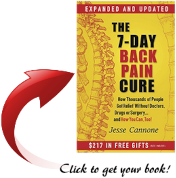 Treat lower back pain with the exercise ball? Yup, you bet! Not only is the exercise ball used effectively for abs workouts, Pilates and Yoga, but for flexibility as well as for improving one’s posture. In fact, the use of an exercise ball is considered good therapy for for minimizing, “rehabing” and preventing pain in the lower back. Although the exercise ball has these therapeutic advantages, the issue is selecting the appropriate size for your needs. You could link up with a professional in the field of fitness and rehabilitation to get you set-up with the right-sized exercise ball, however, if you’re squeezed for time, I have some info that may help you. Below are the guidelines established to help you select the exercise ball that will meet your lower back pain needs.
Treat lower back pain with the exercise ball? Yup, you bet! Not only is the exercise ball used effectively for abs workouts, Pilates and Yoga, but for flexibility as well as for improving one’s posture. In fact, the use of an exercise ball is considered good therapy for for minimizing, “rehabing” and preventing pain in the lower back. Although the exercise ball has these therapeutic advantages, the issue is selecting the appropriate size for your needs. You could link up with a professional in the field of fitness and rehabilitation to get you set-up with the right-sized exercise ball, however, if you’re squeezed for time, I have some info that may help you. Below are the guidelines established to help you select the exercise ball that will meet your lower back pain needs.
Various Sizes For The Exercise Ball
In general, there are 5 sizes to select from, and they’re categorized by the size of the ball’s diameter in centimeters (cm). Here’s a table of the recommended sizes based on your height.
| Diameter (cm) | Your Height |
| 45 | 5ft and under |
| 55 | 5ft 1in to 5ft 8in |
| 65 | 5ft 9in to 6ft 2in |
| 75 | 6ft 3in to 6ft 7in |
| 85 | 6ft 8in and up |
Selecting The Right Exercise Ball
Note, though, that an individual’s height is just one factor in selecting the right-sized exercise ball. Another factor is the weight of the individual. If you’re of a heavier build, the exercise ball will compress a lot more than average. And thus, it may be necessary to select a bigger exercise ball that falls in the next size. Also, there are exercise balls with adjustable settings, which could possibly be a more ideal option for heavier individuals.
To select the appropriate exercise ball, you can do what experts call the “90-degree test”. This is how to do the “test”:
- Plant both feet flat on the floor while sitting upright on an inflated exercise ball
- Insure that your weight is distributed evenly on the exercise ball
- Your knees should make at least a 90-degree angle
- Your knees should be level or a little lower than the pelvis
- Your pelvis, up to the shoulders and ears should be aligned vertically
- Insure the vertical alignment is stable without excessive movement to maintain it
- Test the stability of the vertical alignment by bouncing gently on the exercise ball
Lower Back Workout With The Exercise Ball
Here’s a video that shows you how to use the exercise ball to help you alleviate pain in the lower back. Enjoy!
In closing, I want to mention that you can also adjust the exercise ball yourself. Now if the the angle of your knees and hip is way greater than 90 degrees, just deflate the ball a bit. I guess for those who haven’t used an exercise ball or are just getting into shape now, a flatter ball is probably a better option since it will be easier to maneuver due to its stability. If you are in pretty good shape and/or have been using an exercise ball in your workouts, then you would want to use a more firmer ball to work on your lower back for balance and stability.




